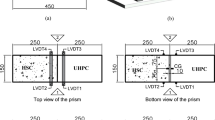Abstract
In the present work, dynamic tensile strength of concrete is experimentally investigated by means of spalling tests. Based on extensive numerical simulations, the paper presents several advances to improve the processing of spalling tests. The striker is designed to get a more uniform tensile stress field in the specimen. Three methods proposed in the literature to deduce the dynamic strength of the specimen are discussed as well as the use of strain gauges and a laser extensometer. The experimental method is applied to process data of several tests performed on wet micro-concrete at strain rates varying from 30 to 150/s. A significant increase of the dynamic tensile strength with strain-rate is observed and compared with data of the literature. In addition, post-mortem studies of specimens are carried to improve the analysis of damage during spalling tests.

















Similar content being viewed by others
References
Goldsmith W, Polivka M, Yang T (1966) Dynamic behavior of concrete. Exp Mech 6(2):65–79
Birkimer DL, Lindermann R (1971) Dynamic tensile test of concrete materials. ACI J 68(8):47–49
Malvar LJ, Ross CA (1998) Review of strain rate effects for concrete in tension. ACI Mater J 95(6):735–739
Toutlemonde F (1994) Ph.D. thesis: Résistance au choc des structures en béton : du comportement du matériau au calcul des ouvrages. LCPC, Paris
Rossi P (1991) A physical phenomenon which can explain the material behaviour of concrete under high strain rates. Mater Struct 24:422–424
Körmeling HA, Zielinski AJ, Reinhardt HW (1980) Experiments on concrete under single and repeated uniaxial impact tensile loading. Stevin Report 5-80-3, Delft
Zielinski AJ (1982) Ph.D. thesis: fracture of concrete and mortar under uniaxial impact tensile loading. Delft University of Technology
McVay MK (1988) Spall damage of concrete structures. Technical Report SL-88-22, US Army Corps of Engineers, Waterways Experiment Station, Vicksburg, Miss., USA
Klepaczko JR, Brara A (2001) An experimental method for dynamic tensile testing of concrete by spalling. Int J Impact Eng 25:387–409
Schuler H, Mayrhofer C, Thoma K (2006) Spall experiments for the measurement of the tensile strength and fracture energy of concrete at high strain rates. Int J Impact Eng 32:1635–1650
Novikov SA, Divnov II, Ivanov AG (1966) The study of fracture of steel, aluminium and copper under explosive loading. Fizika Metallov i Metallovedeniye 21(4)
Vegt I, Weerheijm J (2006) Dynamic response of concrete at high loading rates. A new Hopkinson bar device. In Proc Int Symp. Brittle Matrix Composites 8, Warsaw
Weerheijm J, Van Doormaal JCAM (2007) Tensile failure of concrete at high loading rates: new test data on strength and fracture energy from instrumented spalling tests. Int J Impact Eng 34:609–626
Forquin P (2003) Ph.D. thesis: Endommagement et fissuration de matériaux fragiles sous impact balistique, rôle de la microstructure. LMT, Cachan
Bernier G, Dalle JM (1998) Rapport d’essai de caractérisation des mortiers, Science Pratique S.A.
Gary G, Klepaczko JR (1992) Essai de compression dynamique sur béton, GRECO Geomaterial scientific report, 105–118
Gatuingt F (1999) Ph.D. thesis: Prévision de la rupture des ouvrages en béton sollicités en dynamique rapide. LMT, Cachan
Buzaud E (1998) DGA Centre d’Etudes de Gramat, Report: Performances mécaniques et balistiques du microbéton MB50
Forquin P, Gary G, Gatuingt F (2008) A testing technique for concrete under confinement at high rates of strain. Int J Impact Eng 35:425–446
Forquin P, Safa K, Gary G (2009) Influence of free water on the quasi-static and dynamic strength of concrete in confined compression tests, Cement Con. Res. Submitted for publication
Frew DJ, Forrestal MJ, Chen W (2001) Pulse shaping techniques for testing brittle materials with a split Hopkinson pressure bar. Exp Mech 42(1)
Song B, Chen W (2004) Loading and unloading split Hopkinson pressure bar pulse shaping techniques for dynamic hysteretic loops. Exp Mech 44(6)
Chen W, Luo H (2004) Dynamic compressive responses of intact and damaged ceramics from a single split Hopkinson pressure bar experiment. Exp Mech 44(3)
Wu H, Zhang Q, Huang F, Jin Q (2005) Experimental and numerical investigation on the dynamic tensile strength of concrete. Int J Impact Eng 32:605–617
Galvez Diaz-Rubio F, Rodriguez Perez J, Sanchez Galvez V (2002) The spalling of long bars as a reliable method of measuring the dynamic tensile strength of ceramics. Int J Impact Eng 27:161–177
Grady DE, Kipp ME (1980) Oil shale fracture and fragmentation at high rates of loading, SAND-76-0563C. Sandia Report
Denoual C, Hild F (2000) A damage model for the dynamic fragmentation of brittle solids. Comp Methods Appl Mech Eng 183:247–258
Hild F, Denoual C, Forquin P, Brajer X (2003) On the probabilistic-deterministic transition involved in a fragmentation process of brittle materials. Comput Struct 81(12):1241–1254
Forquin P, Hild F (2008) Dynamic fragmentation of an ultra-high strength concrete during Edge-On Impact tests, ASCE Journal of Engineering Mechanics. ASCE J Eng Mech 134(4):302–315
Forquin P, Hild F. A probabilistic damage model of the dynamic fragmentation process in brittle materials, Advances in Applied Mechanics, Submitted for publication
Bischoff PH, Perry SH (1991) Compressive behaviour of concrete at high strain rates. Mater Struct 24:425–450
Schmidt JM (2003) Ph.D. thesis: high pressure and strain-rate behaviour of cementious materials: experiments and elastic/viscoplastic modelling. University of Florida, USA
Acknowledgments
The authors are grateful to I. Vegt from TNO, Professor F. Hild from LMT-Cachan, Professors J.R. Klepaczko and L. Toth from LPMM and to Délégation Générale pour l’Armement - Centre d’Etudes de Gramat for supporting this work.
Author information
Authors and Affiliations
Corresponding author
Rights and permissions
About this article
Cite this article
Erzar, B., Forquin, P. An Experimental Method to Determine the Tensile Strength of Concrete at High Rates of Strain. Exp Mech 50, 941–955 (2010). https://doi.org/10.1007/s11340-009-9284-z
Received:
Accepted:
Published:
Issue Date:
DOI: https://doi.org/10.1007/s11340-009-9284-z




